Marta Lorenzini
Human-Robot Interfaces and Interaction, Istituto Italiano di Tecnologia
Graph-based Online Monitoring of Train Driver States via Facial and Skeletal Features
May 09, 2025Abstract:Driver fatigue poses a significant challenge to railway safety, with traditional systems like the dead-man switch offering limited and basic alertness checks. This study presents an online behavior-based monitoring system utilizing a customised Directed-Graph Neural Network (DGNN) to classify train driver's states into three categories: alert, not alert, and pathological. To optimize input representations for the model, an ablation study was performed, comparing three feature configurations: skeletal-only, facial-only, and a combination of both. Experimental results show that combining facial and skeletal features yields the highest accuracy (80.88%) in the three-class model, outperforming models using only facial or skeletal features. Furthermore, this combination achieves over 99% accuracy in the binary alertness classification. Additionally, we introduced a novel dataset that, for the first time, incorporates simulated pathological conditions into train driver monitoring, broadening the scope for assessing risks related to fatigue and health. This work represents a step forward in enhancing railway safety through advanced online monitoring using vision-based technologies.
Learning and Online Replication of Grasp Forces from Electromyography Signals for Prosthetic Finger Control
May 05, 2025Abstract:Partial hand amputations significantly affect the physical and psychosocial well-being of individuals, yet intuitive control of externally powered prostheses remains an open challenge. To address this gap, we developed a force-controlled prosthetic finger activated by electromyography (EMG) signals. The prototype, constructed around a wrist brace, functions as a supernumerary finger placed near the index, allowing for early-stage evaluation on unimpaired subjects. A neural network-based model was then implemented to estimate fingertip forces from EMG inputs, allowing for online adjustment of the prosthetic finger grip strength. The force estimation model was validated through experiments with ten participants, demonstrating its effectiveness in predicting forces. Additionally, online trials with four users wearing the prosthesis exhibited precise control over the device. Our findings highlight the potential of using EMG-based force estimation to enhance the functionality of prosthetic fingers.
PRO-MIND: Proximity and Reactivity Optimisation of robot Motion to tune safety limits, human stress, and productivity in INDustrial settings
Sep 10, 2024Abstract:Despite impressive advancements of industrial collaborative robots, their potential remains largely untapped due to the difficulty in balancing human safety and comfort with fast production constraints. To help address this challenge, we present PRO-MIND, a novel human-in-the-loop framework that leverages valuable data about the human co-worker to optimise robot trajectories. By estimating human attention and mental effort, our method dynamically adjusts safety zones and enables on-the-fly alterations of the robot path to enhance human comfort and optimal stopping conditions. Moreover, we formulate a multi-objective optimisation to adapt the robot's trajectory execution time and smoothness based on the current human psycho-physical stress, estimated from heart rate variability and frantic movements. These adaptations exploit the properties of B-spline curves to preserve continuity and smoothness, which are crucial factors in improving motion predictability and comfort. Evaluation in two realistic case studies showcases the framework's ability to restrain the operators' workload and stress and to ensure their safety while enhancing human-robot productivity. Further strengths of PRO-MIND include its adaptability to each individual's specific needs and sensitivity to variations in attention, mental effort, and stress during task execution.
The Bridge between Xsens Motion-Capture and Robot Operating System : Enabling Robots with Online 3D Human Motion Tracking
Jun 30, 2023Abstract:This document introduces the bridge between the leading inertial motion-capture systems for 3D human tracking and the most used robotics software framework. 3D kinematic data provided by Xsens are translated into ROS messages to make them usable by robots and a Unified Robotics Description Format (URDF) model of the human kinematics is generated, which can be run and displayed in ROS 3D visualizer, RViz. The code to implement the to-ROS-bridge is a ROS package called xsens_mvn_ros and is available on GitHub at https://github.com/hrii-iit/xsens_mvn_ros The main documentation can be found at https://hrii-iit.github.io/xsens_mvn_ros/index.html
Maximising Coefficiency of Human-Robot Handovers through Reinforcement Learning
Jun 12, 2023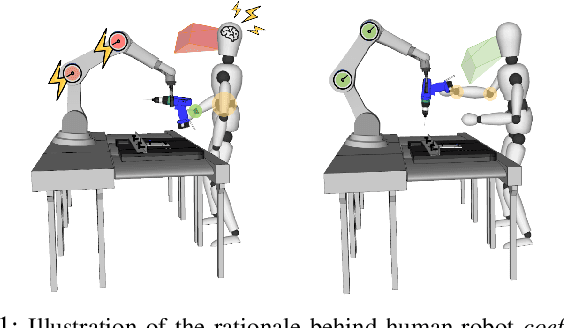
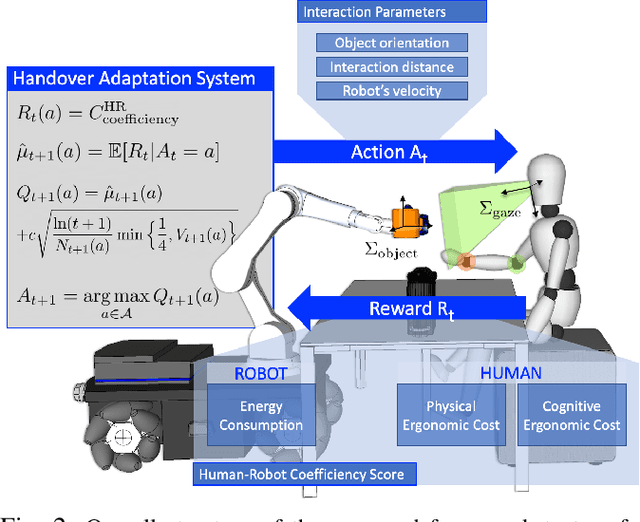
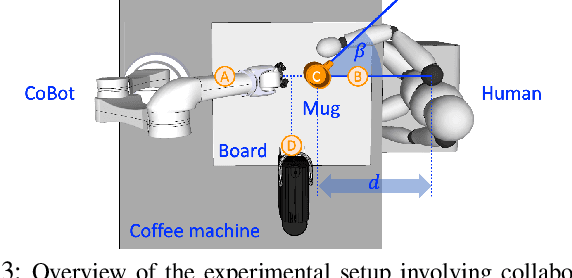
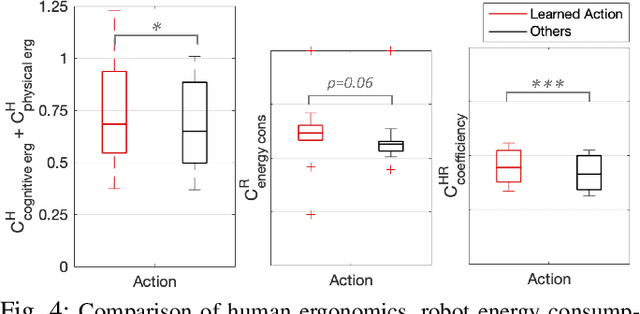
Abstract:Handing objects to humans is an essential capability for collaborative robots. Previous research works on human-robot handovers focus on facilitating the performance of the human partner and possibly minimising the physical effort needed to grasp the object. However, altruistic robot behaviours may result in protracted and awkward robot motions, contributing to unpleasant sensations by the human partner and affecting perceived safety and social acceptance. This paper investigates whether transferring the cognitive science principle that "humans act coefficiently as a group" (i.e. simultaneously maximising the benefits of all agents involved) to human-robot cooperative tasks promotes a more seamless and natural interaction. Human-robot coefficiency is first modelled by identifying implicit indicators of human comfort and discomfort as well as calculating the robot energy consumption in performing the desired trajectory. We then present a reinforcement learning approach that uses the human-robot coefficiency score as reward to adapt and learn online the combination of robot interaction parameters that maximises such coefficiency. Results proved that by acting coefficiently the robot could meet the individual preferences of most subjects involved in the experiments, improve the human perceived comfort, and foster trust in the robotic partner.
An Ergonomic Role Allocation Framework for Dynamic Human-Robot Collaborative Tasks
Jan 19, 2023Abstract:By incorporating ergonomics principles into the task allocation processes, human-robot collaboration (HRC) frameworks can favour the prevention of work-related musculoskeletal disorders (WMSDs). In this context, existing offline methodologies do not account for the variability of human actions and states; therefore, planning and dynamically assigning roles in human-robot teams remains an unaddressed challenge.This study aims to create an ergonomic role allocation framework that optimises the HRC, taking into account task features and human state measurements. The presented framework consists of two main modules: the first provides the HRC task model, exploiting AND/OR Graphs (AOG)s, which we adapted to solve the allocation problem; the second module describes the ergonomic risk assessment during task execution through a risk indicator and updates the AOG-related variables to influence future task allocation. The proposed framework can be combined with any time-varying ergonomic risk indicator that evaluates human cognitive and physical burden. In this work, we tested our framework in an assembly scenario, introducing a risk index named Kinematic Wear.The overall framework has been tested with a multi-subject experiment. The task allocation results and subjective evaluations, measured with questionnaires, show that high-risk actions are correctly recognised and not assigned to humans, reducing fatigue and frustration in collaborative tasks.
ErgoTac-Belt: Anticipatory Vibrotactile Feedback to Lead \\Centre of Pressure during Walking
Jul 08, 2022
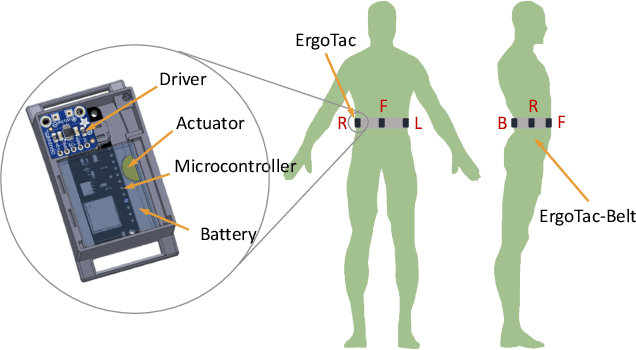
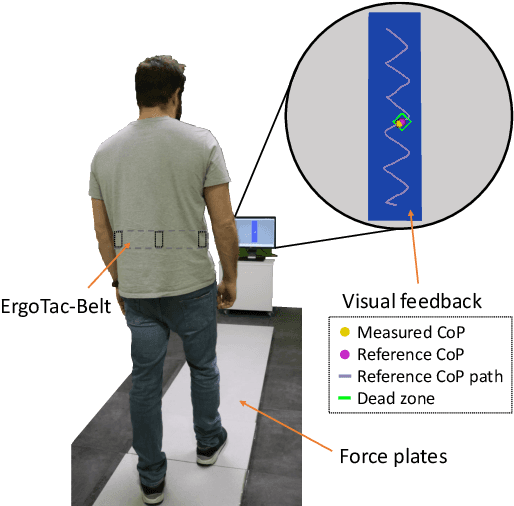
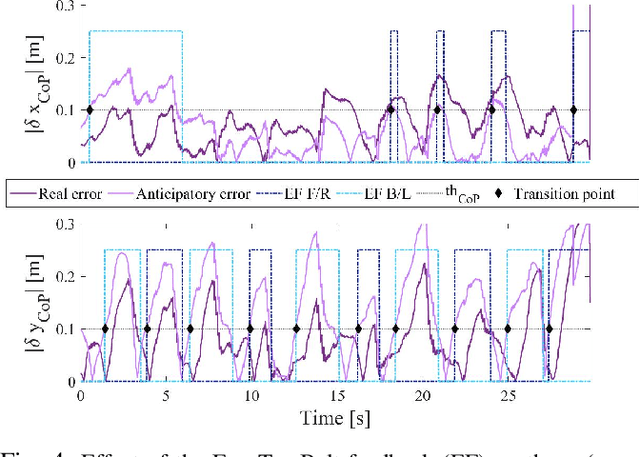
Abstract:Balance and gait disorders are the second leading cause of falls, which, along with consequent injuries, are reported as major public health problems all over the world. For patients who do not require mechanical support, vibrotactile feedback interfaces have proven to be a successful approach in restoring balance. Most of the existing strategies assess trunk or head tilt and velocity or plantar forces, and are limited to the analysis of stance. On the other hand, central to balance control is the need to maintain the body's centre of pressure (CoP) within feasible limits of the support polygon (SP), as in standing, or on track to a new SP, as in walking. Hence, this paper proposes an exploratory study to investigate whether vibrotactile feedback can be employed to lead human CoP during walking. The ErgoTac-Belt vibrotactile device is introduced to instruct the users about the direction to take, both in the antero-posterior and medio-lateral axes. An anticipatory strategy is adopted here, to give the users enough time to react to the stimuli. Experiments on ten healthy subjects demonstrated the promising capability of the proposed device to guide the users' CoP along a predefined reference path, with similar performance as the one achieved with visual feedback. Future developments will investigate our strategy and device in guiding the CoP of elderly or individuals with vestibular impairments, who may not be aware of or, able to figure out, a safe and ergonomic CoP path.
Performance Analysis of Vibrotactile and Slide-and-Squeeze Haptic Feedback Devices for Limbs Postural Adjustment
Jul 08, 2022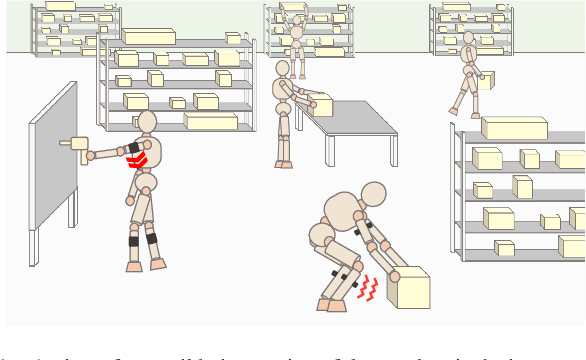

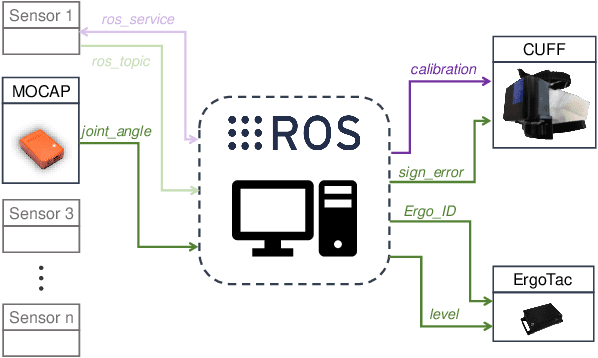
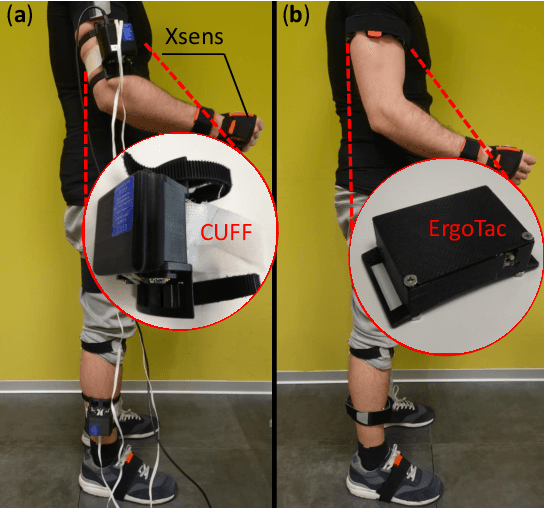
Abstract:Recurrent or sustained awkward body postures are among the most frequently cited risk factors to the development of work-related musculoskeletal disorders (MSDs). To prevent workers from adopting harmful configurations but also to guide them toward more ergonomic ones, wearable haptic devices may be the ideal solution. In this paper, a vibrotactile unit, called ErgoTac, and a slide-and-squeeze unit, called CUFF, were evaluated in a limbs postural correction setting. Their capability of providing single-joint (shoulder or knee) and multi-joint (shoulder and knee at once) guidance was compared in twelve healthy subjects, using quantitative task-related metrics and subjective quantitative evaluation. An integrated environment was also built to ease communication and data sharing between the involved sensor and feedback systems. Results show good acceptability and intuitiveness for both devices. ErgoTac appeared as the suitable feedback device for the shoulder, while the CUFF may be the effective solution for the knee. This comparative study, although preliminary, was propaedeutic to the potential integration of the two devices for effective whole-body postural corrections, with the aim to develop a feedback and assistive apparatus to increase workers' awareness about risky working conditions and therefore to prevent MSDs.
Pick the Right Co-Worker: Online Assessment of Cognitive Ergonomics in Human-Robot Collaborative Assembly
Jul 08, 2022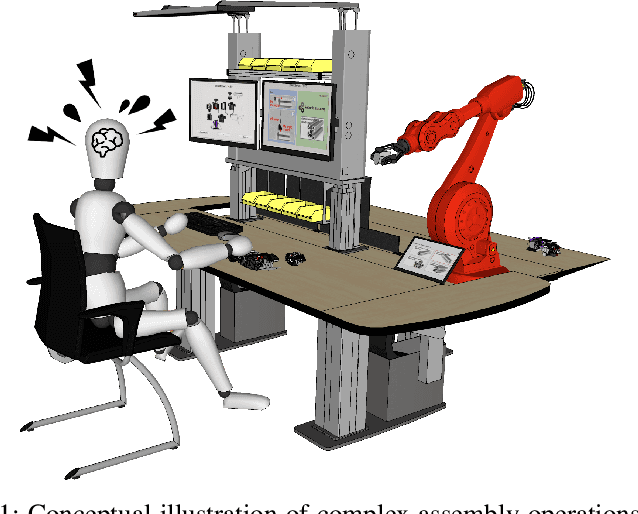
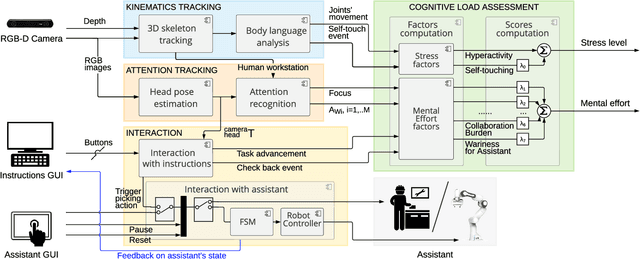

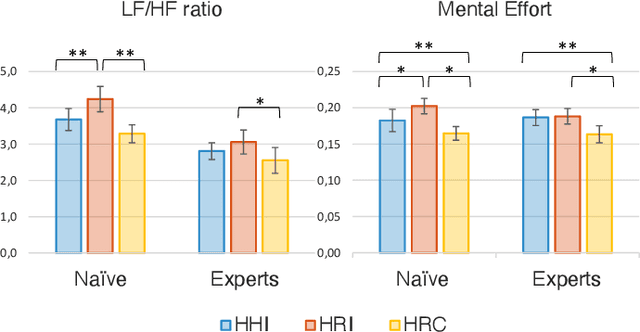
Abstract:Human-robot collaborative assembly systems enhance the efficiency and productivity of the workplace but may increase the workers' cognitive demand. This paper proposes an online and quantitative framework to assess the cognitive workload induced by the interaction with a co-worker, either a human operator or an industrial collaborative robot with different control strategies. The approach monitors the operator's attention distribution and upper-body kinematics benefiting from the input images of a low-cost stereo camera and cutting-edge artificial intelligence algorithms (i.e. head pose estimation and skeleton tracking). Three experimental scenarios with variations in workstation features and interaction modalities were designed to test the performance of our online method against state-of-the-art offline measurements. Results proved that our vision-based cognitive load assessment has the potential to be integrated into the new generation of collaborative robotic technologies. The latter would enable human cognitive state monitoring and robot control strategy adaptation for improving human comfort, ergonomics, and trust in automation.
Robot Trajectory Adaptation to Optimise the Trade-off between Human Cognitive Ergonomics and Workplace Productivity in Collaborative Tasks
Jul 08, 2022
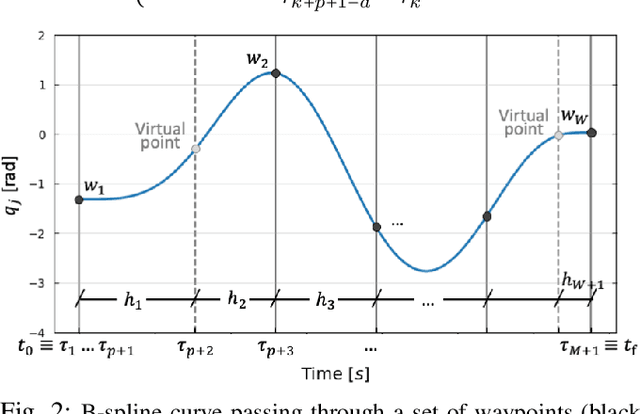


Abstract:In hybrid industrial environments, workers' comfort and positive perception of safety are essential requirements for successful acceptance and usage of collaborative robots. This paper proposes a novel human-robot interaction framework in which the robot behaviour is adapted online according to the operator's cognitive workload and stress. The method exploits the generation of B-spline trajectories in the joint space and formulation of a multi-objective optimisation problem to online adjust the total execution time and smoothness of the robot trajectories. The former ensures human efficiency and productivity of the workplace, while the latter contributes to safeguarding the user's comfort and cognitive ergonomics. The performance of the proposed framework was evaluated in a typical industrial task. Results demonstrated its capability to enhance the productivity of the human-robot dyad while mitigating the cognitive workload induced in the worker.
 Add to Chrome
Add to Chrome Add to Firefox
Add to Firefox Add to Edge
Add to Edge